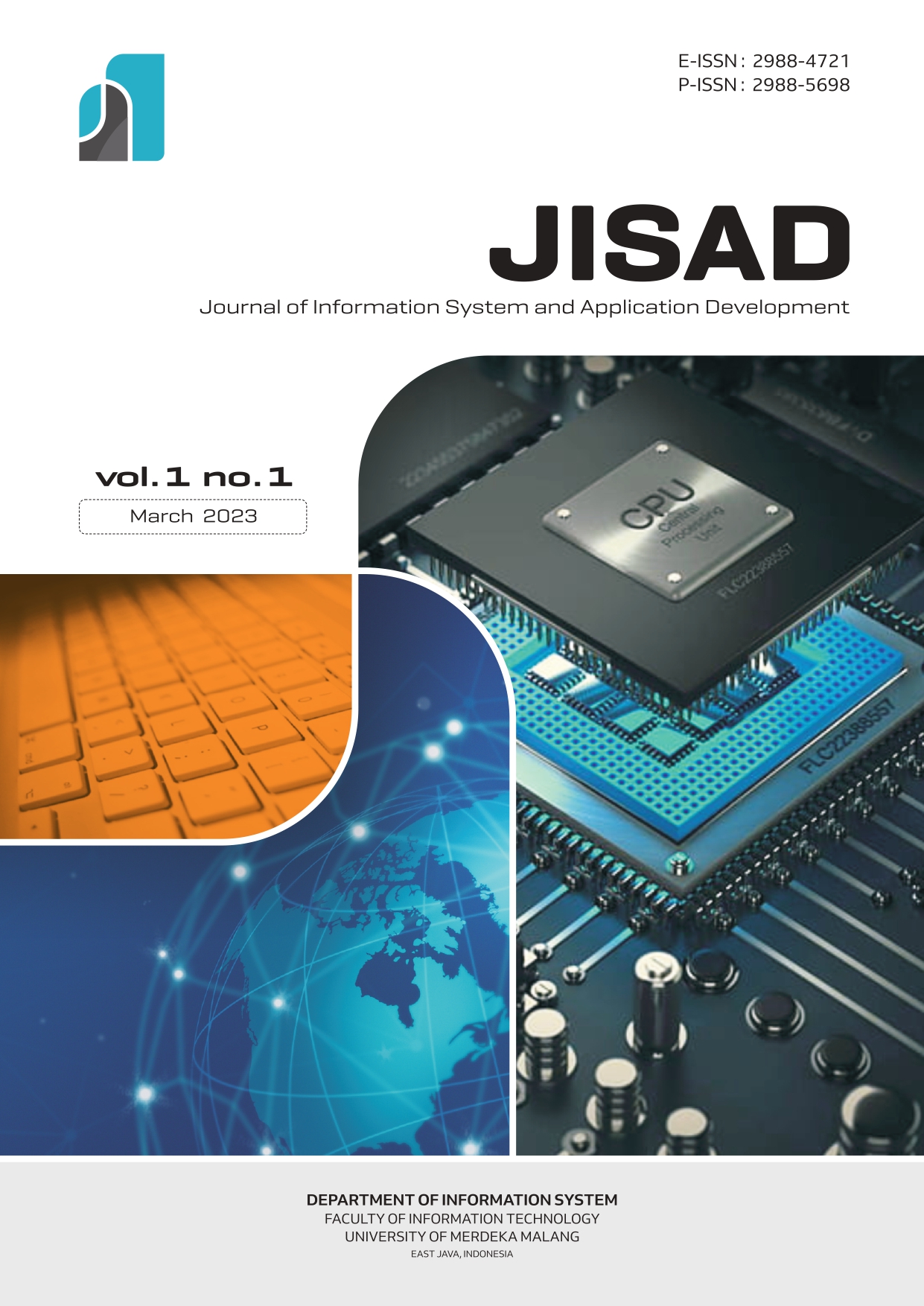Analisis prediktif perubahan nilai profit berdasarkan klasifikasi pengguna pada usaha jasa logistik
DOI:
https://doi.org/10.26905/jisad.v1i1.9865Keywords:
logistics services, classification, regression, predictionAbstract
The delivery of logistics services continues to experience a rapid increase in line with the high sales of goods through e-commerce. According to the predetermined standards, each cargo expedition outlet is required to meet the monthly shipment achievement target (tonnage) to avoid fines and an increase in the target rate. This study aims to find out how to anticipate failure to achieve targets, so as to prevent additional operating expenses and profit instability. In this study, quantitative analysis was carried out using two algorithms. The Naïve Bayes algorithm is used to classify service user categories. The results showed that the industrial category contributed greatly to the delivery of cargo expeditions with a total tonnage percentage of 69.33%, while the remaining 30.67% was included in the individual category. Furthermore, the Multiple Linear Regression algorithm is used to predict profit values based on category classes. Predictions were made from October to December which resulted in an increase in profit for the individual category and a decrease in profit for the industrial category. Recommendations that can be made include royalty rewards for customers, brand awareness to attract new customers, as well as business cooperation with MSMEs and other business actors around them.
Downloads
References
[1] D. Hendarsyah, “E-Commerce Di Era Industri 4.0 Dan Society 5.0,” IQTISHADUNA J. Ilm. Ekon. Kita, vol. 8, no. 2, Art. no. 2, Dec. 2019, doi: 10.46367/iqtishaduna.v8i2.170.
[2] D. Sudrajat, “Kapabilitas Dinamik, Kinerja Inovasi, dan Kinerja Perusahaan Jasa Logistik di Indonesia (Suatu Kerangka Penelitian),” Binus Bus. Rev., vol. 4, no. 2, Art. no. 2, Nov. 2013, doi: 10.21512/bbr.v4i2.1396.
[3] F. Triagustina and L. Gani, “Usulan Time-Driven Activity Based Costing System, Customer Profitability Analysis dan Sistem Pengendalian Internal pada Perusahaan Logistik,” J. Ris. Akunt. Perpajak. JRAP, vol. 8, no. 01, Art. no. 01, Jun. 2021, doi: 10.35838/jrap.2021.008.01.01.
[4] R. Kasengkang, “Analisis logistik (studi kasus pada PT. Remenia Satori Tepas-Kota Manado),” J. Berk. Ilm. Efisiensi, vol. 16, no. 1, Art. no. 1, Apr. 2016,
[5] R. Ananda, S. Sumarno, and I. Gunawan, “Prediksi Promosi Jabatan Karyawan JNE Pematangsiantar Dengan Algoritma C4.5,” J. Sist. Komput. Dan Inform. JSON, vol. 3, no. 3, Art. no. 3, Mar. 2022, doi: 10.30865/json.v3i3.3763.
[6] V. Afifah and D. Setyantoro, “Rancangan Sistem Pemilihan dan Penetapan Harga dalam Proses Pengadaan Barang dan Jasa Logistik Berbasis Web,” Ikraith-Inform., vol. 5, no. 2, Art. no. 2, 2021.
[7] Y. Mardi, “Data Mining : Klasifikasi Menggunakan Algoritma C4.5,” J. Edik Inform. Penelit. Bid. Komput. Sains Dan Pendidik. Inform., vol. 2, no. 2, Art. no. 2, Feb. 2017, doi: 10.22202/ei.2016.v2i2.1465.
[8] N. Nendi and A. Wibowo, “Prediksi Jumlah Pengiriman Barang Menggunakan Kombinasi Metode Support Vector Regression, Algoritma Genetika dan Multivariate Adaptive Regression Splines,” J. Teknol. Inf. Dan Ilmu Komput., vol. 7, no. 6, Art. no. 6, Dec. 2020, doi: 10.25126/jtiik.2020722441.
[9] H. W. Herwanto, T. Widiyaningtyas, and P. Indriana, “Penerapan Algoritme Linear Regression untuk Prediksi Hasil Panen Tanaman Padi,” J. Nas. Tek. Elektro Dan Teknol. Inf., vol. 8, no. 4, Art. no. 4, Nov. 2019.
[10] M. Sholeh, “Penerapan Regresi Linear Ganda Untuk Memprediksi Hasil Nilai Kuesioner Mahasiswa Dengan Menggunakan Python,” J. Din. Inform., vol. 11, no. 1, Art. no. 1, Apr. 2022.
[11] G. P. Kawani, “Implementasi Naive Bayes,” J. Inform. Inf. Syst. Softw. Eng. Appl. INISTA, vol. 1, no. 2, Art. no. 2, May 2019, doi: 10.20895/inista.v1i2.73.
[12] D. Larassati, A. Zaidiah, and S. Afrizal, “Sistem Prediksi Penyakit Jantung Koroner Menggunakan Metode Naive Bayes,” JIPI J. Ilm. Penelit. Dan Pembelajaran Inform., vol. 7, no. 2, Art. no. 2, May 2022, doi: 10.29100/jipi.v7i2.2842.
[13] M. A. Hasanah, S. Soim, and A. S. Handayani, “Implementasi CRISP-DM Model Menggunakan Metode Decision Tree dengan Algoritma CART untuk Prediksi Curah Hujan Berpotensi Banjir,” J. Appl. Inform. Comput., vol. 5, no. 2, Art. no. 2, Oct. 2021, doi: 10.30871/jaic.v5i2.3200.
[14] S. Aisyah, S. Wahyuningsih, and F. Amijaya, “Peramalan jumlah titik panas Provinsi Kalimantan Timur menggunakan metode radial basis function neural network,” Jambura J. Probab. Stat., vol. 2, no. 2, Art. no. 2, Nov. 2021, doi: 10.34312/jjps.v2i2.10292.
[15] M. R. Qisthiano, T. B. Kurniawan, E. S. Negara, and M. Akbar, “Pengembangan Model Untuk Prediksi Tingkat Kelulusan Mahasiswa Tepat Waktu dengan Metode Naïve Bayes,” J. MEDIA Inform. BUDIDARMA, vol. 5, no. 3, Art. no. 3, Jul. 2021, doi: 10.30865/mib.v5i3.3030.
[16] E. Siegel, Predictive Analytics. John Wiley & Sons, Inc., 2016.
[17] A. T. Basuki and N. Prawoto, Analisis Regresi Dalam Penelitian Ekonomi & Bisnis. Rajawali Pers, 2015.
Downloads
Additional Files
Published
Issue
Section
License
Copyright (c) 2023 Journal of Information System and Application Development

This work is licensed under a Creative Commons Attribution-ShareAlike 4.0 International License.
Authors who publish in this journal agree to the following terms:
(1) Copyright of the published articles will be transferred to the journal as the publisher of the manuscripts. Therefore, the author confirms that the journal has managed the copyright.
(2) Publisher of JISAD: Journal of Information System and Application Development is the University of Merdeka Malang.
(3) The copyright follows Creative Commons Attribution ShareAlike License (CC BY SA): This license allows to Share - copy and redistribute the material in any medium or format, Adapt - remix, transform, and build upon the material, for any purpose, even commercially.






